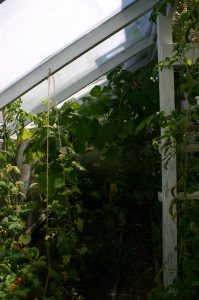What can be better than going out to your garden, picking a few sun-warmed tomatoes and enjoying them for lunch or dinner? Tomatoes are the most popular garden plant grown in America, but do you know your determinate from your indeterminate? Your heirloom from your hybrid? Or why some tomatoes have VF, A, FF, or VFNT next to their name while others have nothing?
Determinate tomatoes are bred for harvesting all at once. Typically, the plants grow four to six feet tall and the tomatoes ripen at the same time. They are often hybrid tomatoes bred for market. But they may also be grown for making sauce or tomato paste when having a ton of tomatoes enables you to make a lot of sauce.
On the other hand, Indeterminate tomatoes are often grown by the home gardener who likes to pick two or three tomatoes each day over a relatively long time. Indeterminate tomatoes can grow up to twenty feet tall and may continue to produce until frost.

Heirloom tomatoes are tomatoes that have been grown in America for at least 40 years with the seed preserved from year to year. Quite often they are tastier than hybrids and may have varied shapes and sizes. In fact, some, such as Granny Cantrell, for example, may weigh up to two pounds and can have many lobes on the fruit.
Hybrid tomatoes are tomatoes bred from two or more different parents to try to obtain specific traits. Disease resistance, higher yields, earlier maturity, shelf life, and consistent size are all features that may be bred into hybrid tomatoes. If you try to grow a seed from a hybrid you might get a plant that either has the traits of one of the parents – and there may be many – or is sterile.

If you see a tomato seed packet or plant with its name and some initials after it, it means that the plant is resistant to certain diseases. V means the plant is resistant to Verticillium wilt. F indicates resistance to Fusarium wilt. N is resistance to Nematodes, A means it has resistance to Alternaria stem Canker, while T is resistance to Tobacco Mosiac Virus.
If you have grown tomatoes in the same spot for a number of years and have seen your harvests decline, you may have one or more of the above diseases in the ground. If so, you may want to either move your growing area or grow tomatoes with resistance to these diseases. Tobacco Mosiac Virus is typically transmitted by a smoker who does not wash their hands before handling plant materials.
Now that’s out of the way, we’ll look at keeping production high. Typically, tomato plants should be fertilized with 5-10-5 fertilizer to keep them setting flowers and fruit. The first, 5 means that the fertilizer has 5% by weight of nitrogen. Nitrogen (N) promotes green growth. The second number, 10, is phosphorus (P). It promotes flowers and strong root growth, while the last 5 is potassium (K) helps to regulate growth and plant health. Tomato plants should be encouraged to set many flowers that ultimately develop into many fruits.

I like to sprinkle about a teaspoon of fertilizer in the hole when I first set the plant in the ground and water weakly weekly – that is, using about ¼ to 1/3 of the recommended dose each week, rather than using a full dose every month or so. I find this helps the plant during our hot dry summers.


